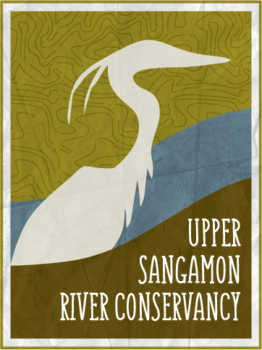A test:
Suppose you have two potential routes between Point A and Point B. The first route takes 15 minutes, the other route takes 4 hours. Which route do you choose?
99% of you picked the first route. But if you’re like me, you’re part of the 1% that picks life in the slow lane.
Maybe it’s time to slow down and ask the question why, without providing any additional details such as what was actually AT Point B, you wanted to get there so freakin’ FAST?
But for now, let’s skip the destination and talk about the ride. In this case, the first route is in a car, via County Road, cruising along about 60, and the second is in a canoe, via the Sangamon River, cruising along at approximately 1.
So why slow down?
The slower you go, the closer you look, and the closer you look, the more you see.
As an example, the USRC recently did a highway cleanup along Illinois 47 north of Interstate 74. While driving, I saw a few discarded items here and there along the way, suggesting that the route could perhaps use some cleaning.
But after our crew completed the task, on foot and looking closely at the ground for the entire two mile “adopted” route, we filled up at least SEVEN extra large heavy trash bags with junk, mostly pitched out of people’s windows.
When most of us look at a forest, we see trees, or when we look up at the sky at night, we see stars. But when we take time to look more closely and identify trees by their leaves, or the constellations at night, we see white oaks, Orion the Hunter, silver maples, hackberries, hawthorns, and Casseiopia the Queen.
The Sangamon River is no different. When we pass by quickly even the river itself can be easily missed. During a conversation with a resident that has lived here for several years, she asked me “where, exactly does the Sangamon River cross through Mahomet?” I explained that she crosses over it every time she leaves or comes into town on US 150 or Route 47 south of town.
While regular readers (hi, Mom!) may scoff at this notion, she can’t really be blamed. The modern roadway is made to minimize pesky interruptions to high speed, efficient traffic flow such as crossing a river. How many people driving Interstate 74 have any idea they are crossing over one of Illinois “biologically significant streams” as they speed along past Mahomet? There’s not even a sign.
So what’s it like to slow down on the Sangamon?
On one hand, paddling can be tedious. The low banks and hanging trees along the Sangamon frequently fall into the river. And often one fallen tree backs up more fallen trees creating large and nearly impassable “log jams”. Navigating under, around, over, beside or through fallen trees and nearly impenetrable log jams in the river does presents the Sangamon’s most difficult challenges.
But on a recent trip this past Memorial Day, most of the paddlers actually enjoyed the added challenge of navigating past, over, around, and through the Sangamon’s many ‘log jams.’ And while some have proposed massive clearing efforts, in fact, the Sangamon’s log jams have many benefits. They provide habitats for fish and many other species, they control bank erosion, and they slow the flow of the river, which not only allows sediments to settle, the slow flow keeps water in the river longer, meaning that the Sangamon often remains paddleable when others rivers are not.
These low hanging trees shroud nearly the entire path of the Sangamon River through Champaign County in heavy tree cover, keeping paddlers cool on the hottest summer days. Wildlife closes in and wildflowers come to life along the banks. A Great Blue Heron may guide the way and owls, supposed to be asleep, fly off high branches overhead from unnoticed perches. These are the times that paddling the Sangamon can become something else altogether.
Then when the river widens and slows, kayaks and canoes paddle up side by side. And the river carries both the paddlers and the conversation. Conversations may be about travels in Russia, kids in alternative colleges in Oregon, dancing in a zoot suit, biochemistry, the politics of Mahomet, backyard gardening, raising chickens, playing in bands, music, the weather, and just generally provide an opportunity to unplug and get to know things about one another that make us all a bit more human.
And don’t be surprised if your human conservation is interrupted by the screech of a hawk, the caw of a crow, the gobble of a turkey or the hoot of an owl.
So slow down, look closely and notice the small stuff. Strike up a conversation about nothing in particular. You’re almost certain to see and hear things unexpected and to learn things unanticipated. But don’t just take my word for it, recall the words of Robert Frost:
Two roads diverged in the wood and I
I took the one less travelled by
And that has made all the difference.
Appeared as Notes from the River, Mahomet Citizen, 6/14/12, by Scott Hays


